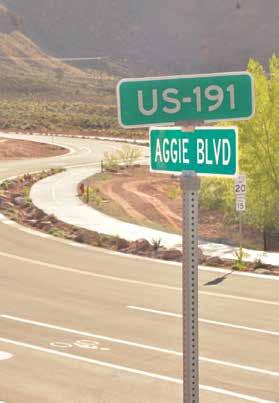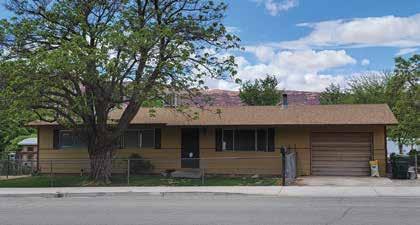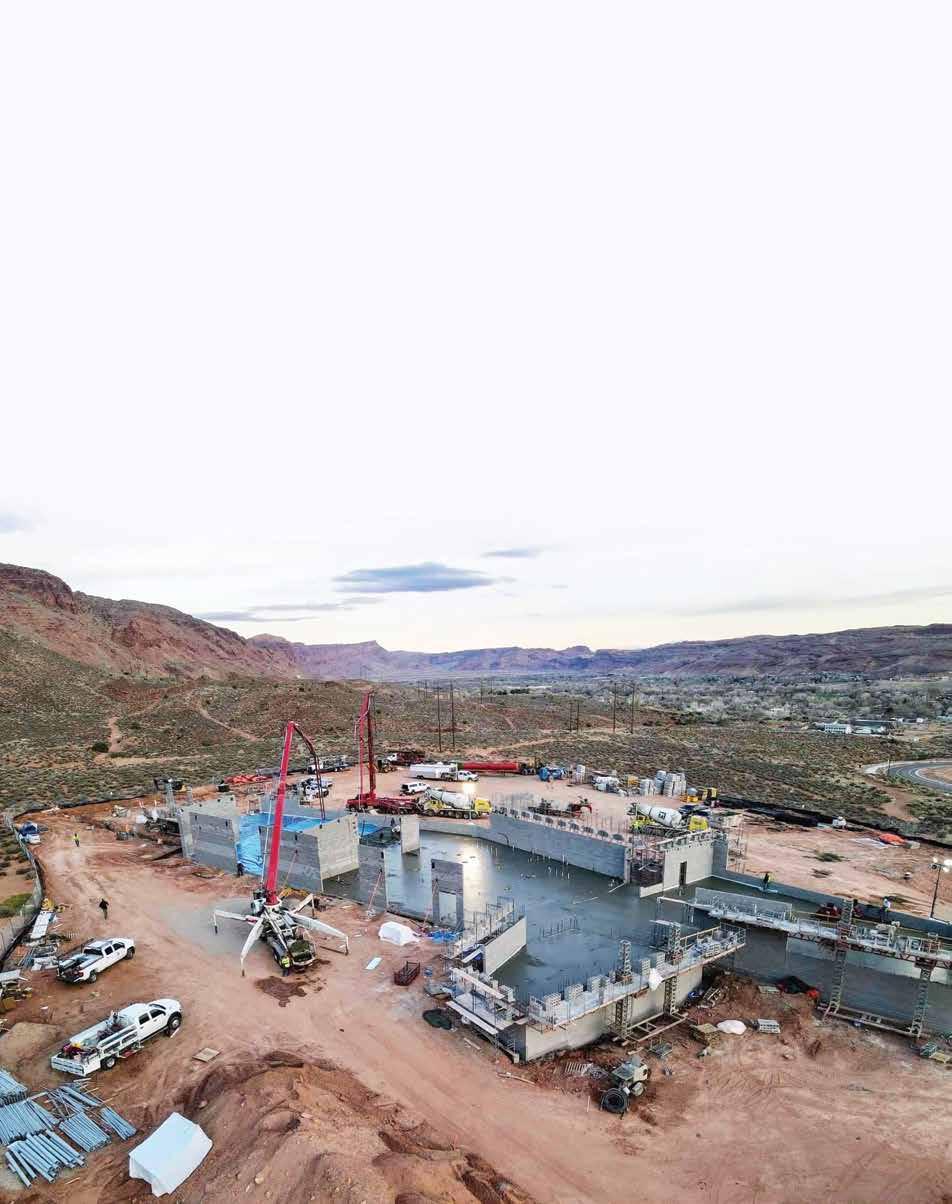
8 minute read
Constructing a campus: USU-Moab
CONSTRUCTING A CAMPUS
Community partnerships and energy efficiency play key roles at USU-Moab’s future home
Written by Sharon Sullivan | Photos by Murice D. Miller
WHEN UTAH STATE UNIVERSITY-MOAB STUDENTS ARRIVE AT THEIR NEW CAMPUS NEXT YEAR THEY’LL BE TRADING CONVERTED OFFICE BUILDINGS FOR A STATE-OF-THE-ART, NET-ZERO ACADEMIC BUILDING THREE MILES SOUTH OF DOWNTOWN. CONSTRUCTION ON THE REGIONAL CAMPUS BEGAN IN FALL 2020, AND IS EXPECTED TO BE COMPLETED NEXT SPRING.

SUSTAINABILITY
The university wanted a “highly sustainable and high-performance” academic building when it comes to energy usage, says Kyle Taft, vice-president of Salt Lake City-based MHTN Architects, and principal architect in charge of the campus project. Utah State University requires new buildings be Silver LEED-certified (Leadership in Energy and Environmental Design), although Taft expects the new Moab academic building will achieve the higher Gold certification.
A photovoltaic array on top of a parking canopy shade structure will produce onsite all of the electricity needed to power the campus – along with a surplus that will go into the electrical grid system.
Lots of windows allow for plenty of natural lighting and direct sunlight for additional warmth during the winter. A large overhang will be used to keep indoor temperatures cool during the summertime. Insulation in the walls and roof will help the building maintain an internal temperature and reduce overall energy usage.
Besides harnessing the sun, architects are also taking advantage of the earth’s constant belowground temperature of around 55 degrees Fahrenheit to heat and cool the 2,000-square-feet building using geothermal technology – a system of wells and pumps that either accept or expel heat from the earth depending on the season.
Additionally, the firm is dealing with the inevitable waste generated during construction projects by separating out various materials, such as concrete and metals, into different waste streams for recycling purposes.
Ironworkers and university officials attended a “topping out” ceremony on May 1 to mark the setting of the new building’s highest and final beam. Along with the American and USU flags, cottonwood and sagebrush branches were attached to represent the region’s riparian and desert habitat. USU-Moab Associate Vice-President Lianna Etchberger and her husband, USUMoab Vice-Provost Rich Etchberger, were on hand to sign the beam, along with ironworkers and construction representatives. Sustainability practices guide the site’s landscaping, too. You won’t find any water-thirsty turf on this campus. Instead, drought-tolerant native plants will be installed to blend into the desert landscape. Drainage water will be captured to irrigate the flowers and shrubs. A demonstration garden on the building’s southwest side will incorporate permaculture principles and will include edible plants to benefit wildlife and pollinators, says MHTN landscape architect Dan Smith.
NEW LABS, SHOPS
With its main campus in Logan, USU has had a Moab presence for the past 50 years, says Lianna Etchberger. Twenty-five years ago, the college flew faculty into Moab once a week to teach classes, she says. These days students learn via interactive live video classes broadcast in real time statewide. Typically, students are required to attend live video broadcasts in the classrooms. However, during the
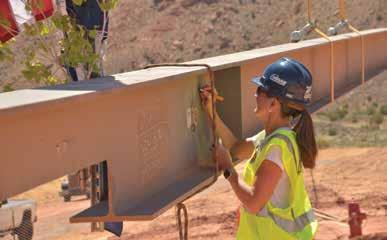
Opposite page: An aerial view of the construction of the new USU-Moab campus. [Courtesy Hogan Construction/USU-Moab] Top: Members of the USU-Moab staff pose for a photo at USU-Moab's future home. From left to right, Allyssa Keogh, Business Assistant; Dianne Wright, Nursing Assistant Instructor; Stephanie Dahlstrom, Career and Technical Education Assistant; Bryton Betty, Automotive Technology Instructor; Lianna Etchberger, Associate Vice President; Aaron Thompson, Building and Construction Instructor; Roslyn McCann, Extension Sustainability Expert and Associate Professor; Shanda Thompson, Academic Advisor; Samantha Campbell, Director of Students. Bottom: As part of a "topping out" ceremony, USU-Moab Associate Vice President Lianna Etchberger adds her signature to others written on the final I-beam to be placed atop the academic building.

COVID-19 pandemic, students and Doctorate degrees. There are have been allowed to view and also various certifications, as well as listen to lectures from home. Stu- “IT’S VALUABLE FOR PEOPLE professional education licensures dents also attend in-person classes and endorsements that students taught by professors who reside in WHO ARE LIVING IN A COMMUNITY TO can achieve at the regional campus. Moab fulltime. The current classroom-admin- HAVE THE OPPORTUNITY TO PURSUE AN Three Ph.D. programs are available in Moab: technical career educaistration building is at 125 W. 200 EDUCATION TO FILL NEEDED ROLES tion, curriculum and instruction, South in downtown Moab. The and education. new regional campus is located IN THE COMMUNITY,” With an approximate 110 stuon 40 acres, three miles south – Jennifer Sadoff dents enrolled in Moab (not countof downtown at the top of Aggie Moab Regional Hospital Chief Executive Officer ing Grand County High School stuBoulevard – a new road that inter- dents taking classes concurrently), sects with U.S. Highway 191 at class sizes are small. While Director Mill Creek Drive. of Students Samantha Campbell
Property for the new campus was donated a new construction shop, as well as a fabrication considers various data to help students succeed, by the Holyoak family of Moab, and then and welding shop. Grand County USU-Extension relationships are key. Being a small campus faciltraded for SITLA (School and Institutional Trust will gain a new demonstration kitchen and activ- itates close relationships between students and Lands Administration) land at the selected loca- ity space. There will be a computer lab and two faculty. “Connectedness is a cool aspect of coming tion, says Etchberger. An additional purchase classrooms that can open up into a larger space to USU-Moab,” Campbell says. increased the land acquisition to 40 acres. for events. Additionally, there are eight small
“We hope the new campus will attract more “pod” rooms for shared studying, or to receive COMMUNITY PARTNERSHIPS of our high school students and even their par- broadcast courses, as well as six individual sta- Programs offered at the Moab campus directly ents,” as higher education can increase income tions for classes with a single student in Moab. benefit the community by providing an educated and lead to meaningful careers, Etchberger says. The cost of the campus project, including install- and trained workforce for fields that need work“It helps the community, overall.” The regional ing utilities to the previously undeveloped site is ers. “I’m really proud of what we do in partnercampus serves mostly non-traditional students $14.5 million. ing with the community,’ Etchberger says. “We (24 and older), who come in after work. Thus, The new classrooms are “designed to promote have an advisory committee with people from most classes are held after 5 p.m. interaction and the exchanging of ideas,” Etch- industry. We tailor things to what the needs are
The new academic building will include a berger says. “We’re growing fast, now,” with more in the community.” science teaching lab (the university currently than 60 different degrees and certificates, and a A dozen students are currently enrolled in shares a lab with Grand County High School), growing tech education department. In Moab the school’s nursing program, and 19 are signed and a health professions lab. There will also be students can earn Bachelor’s, Master’s, Associate up for next year – making nursing USU-Moab’s
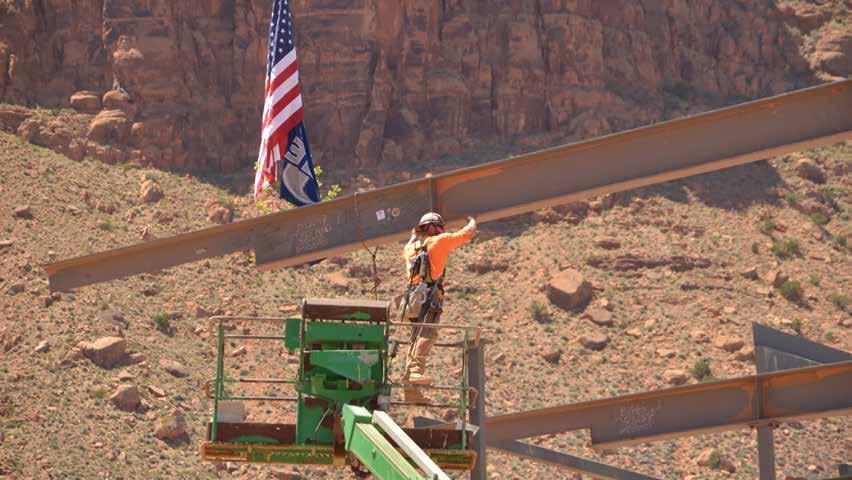
largest program. With a huge nursing shortage nationwide, Moab Regional Hospital (MRH) benefits from people who are already settled in Moab, earning their nursing degrees locally. “It’s valuable for people who are living in a community to have the opportunity to pursue an education to fill needed roles in the community,” says MRH Chief Executive Officer Jennifer Sadoff.
Nursing students train alongside registered nurses at Moab Regional Hospital – collaborations that often lead to employment at the hospital upon graduation. “Because they train on our site, it’s easy to hire them,” Sadoff notes. “They’re already familiar with how we do things; they’re trained here.” Certificates are available in other health professions such as certified nursing assistant and medical assistant.
Professor Wayne Freimund hopes to grow the university’s recreation resource management program in Moab. The coursework involves studying the interface between recreation and stewardship on public lands. There are approximately 100 students enrolled in the program, half of whom are at the Logan campus, while the remainder study at regional campuses statewide.
“Fifty years ago, this program was doing pioneering work learning how to manage recreation on public lands,” he says. Moab’s rich natural resources – wilderness, rivers, and national parks – and all the outdoor activities those resources attract, make Moab “the perfect laboratory,” Freimund says. State and federal agencies such as the National Park Service, the Bureau of Land Management, the U.S. Forest Service, and state parks all enjoy working with USU students and faculty, he notes. “They love having our students come work as interns, working on practical problems in the field,” he says.
USU-Moab’s social work program is another that partners with the community. Students secure internships with local agencies which provide hands-on training and experience, while offering additional support for local organizations, says Jen Evers, USU Moab clinical associate professor of social work. Students can achieve both a Bachelor’s and a Master’s in social work while living in Moab.
Eventually, the campus could expand to include additional classroom buildings, although there are no plans to become a destination campus at this time. “Our mission is to serve the needs of our community, and the local needs will help drive those decisions in the future,” Etchberger says. However, the surrounding SITLA lands will be developed to include affordable housing for students, she adds.
Increasing opportunities to earn a college degree locally, while contributing toward a skilled workforce are among the reasons that organizations like Moab Regional Hospital have supported the new campus project. “When we look at a population’s health we see a connection between people’s level of education and positive health outcomes,” Sadoff says. n
